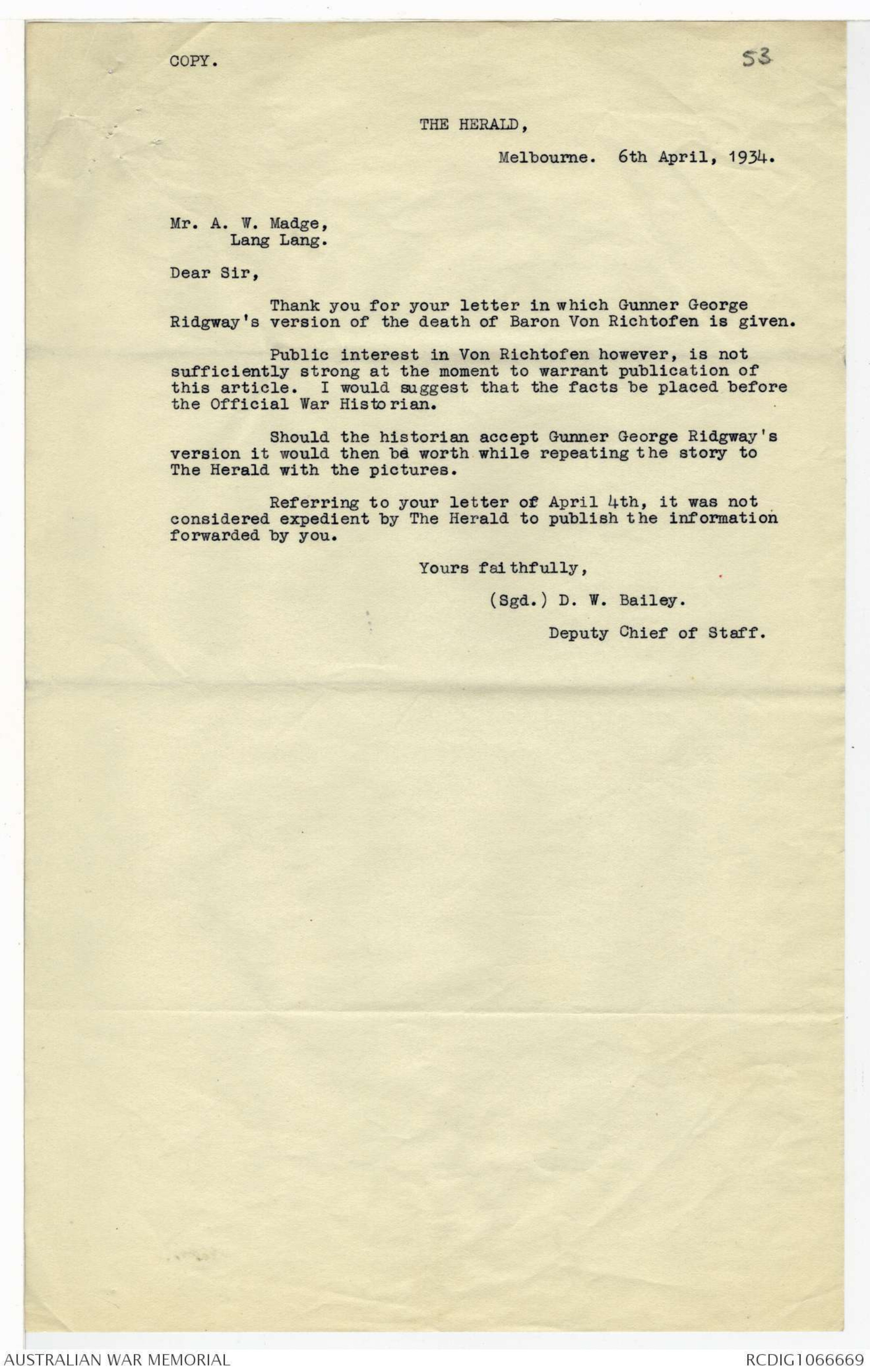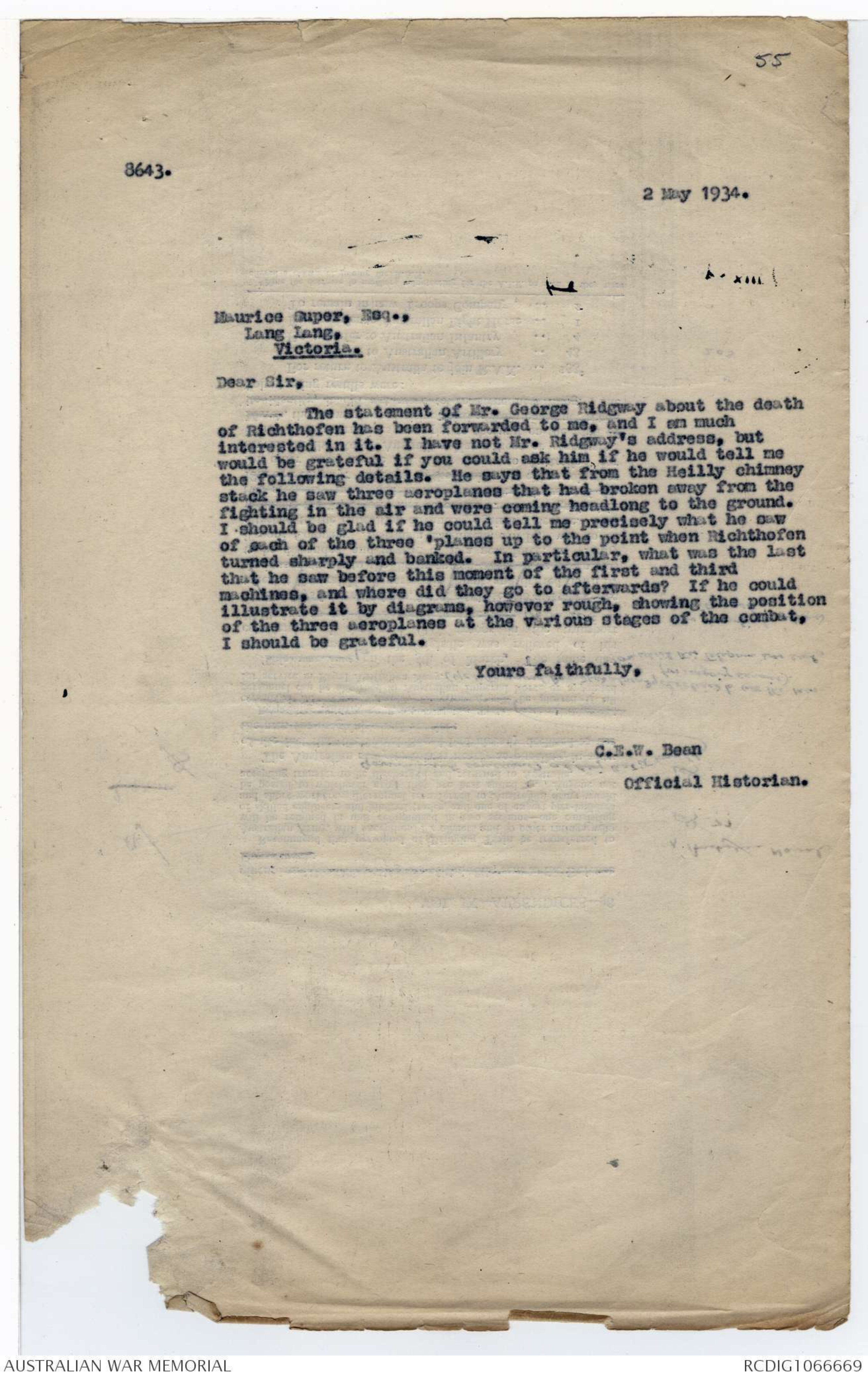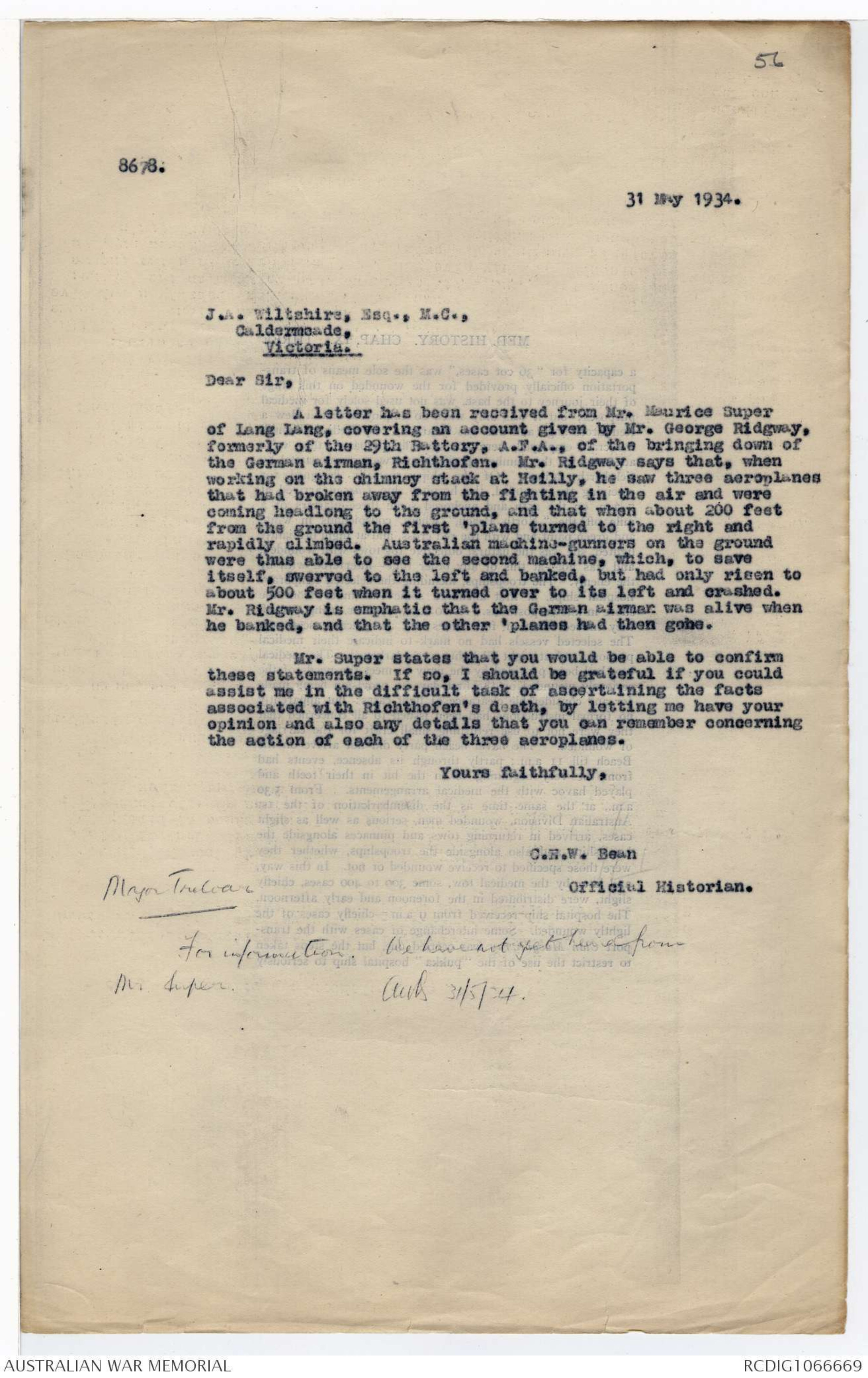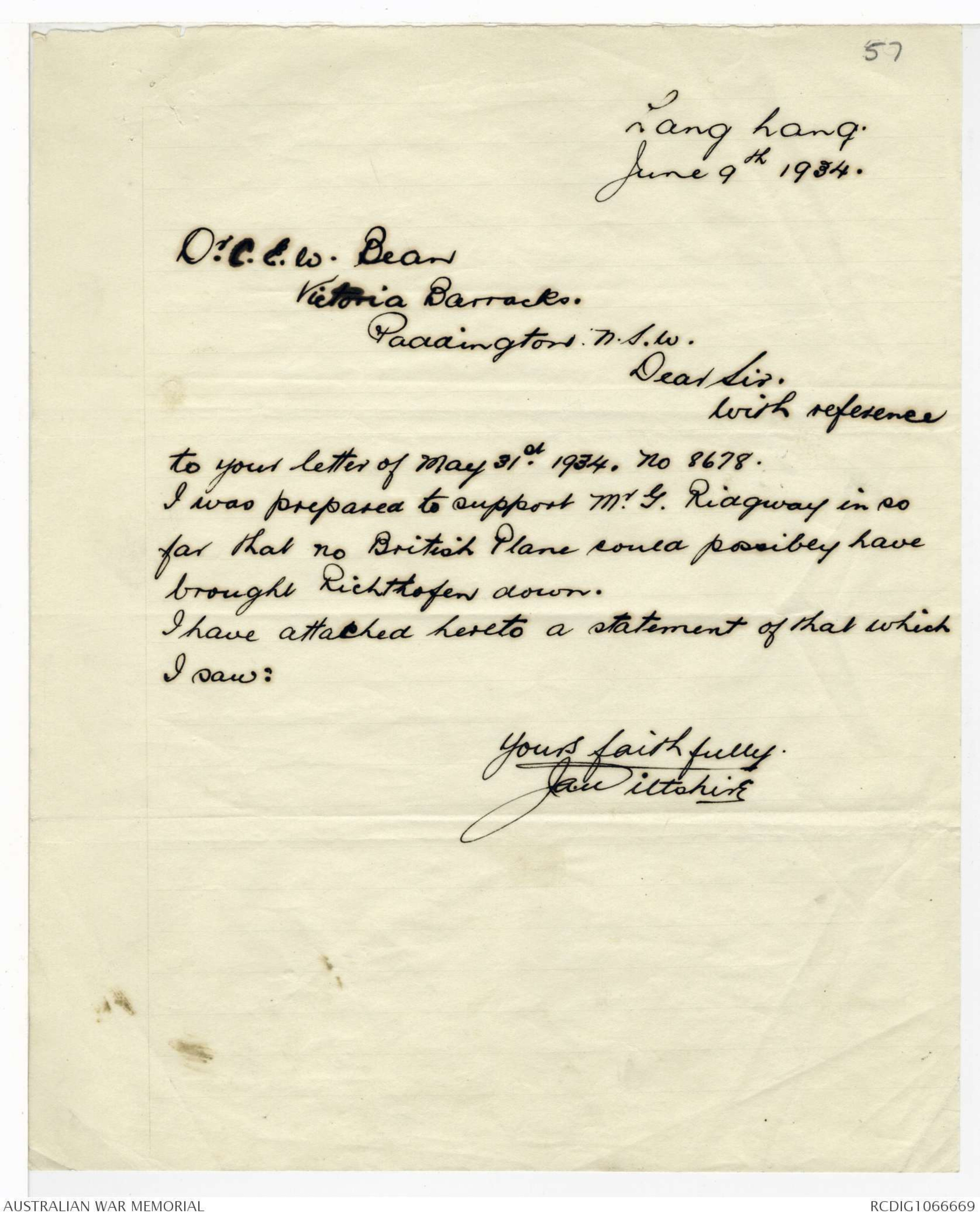Charles E W Bean, Diaries, AWM38 3DRL 606/270 PART 2/1 - 1918 - 1939 - Part 1










AWM38
Official History,
1914-18 War: Records of C E W Bean,
Official Historian.
Diaries and Notebooks
Item number: 3DRL606/270 Part 2/1
Title: Folder, 1918 - 1939
Comprises maps, diagrams, notes, journal
articles and correspondence relating to the
death of Baron von Richthofen.
51
COPY.
Lang Lang,
10/4/34.
Dear Sir,
Kindly read through the enclosures.
Gunner Ridgway's statements can be substantiated by
Lt. John A. Wiltshire,
23rd Battalion,
who was also there.
Diggers in this district as elsewhere hope that even
at this late date it will not be too late to correct the
misstatements as to Richtofen's death.
Please return the typed matter as soon as possible.
Yours truly,
(Sgd.) Maurice Super.
52
COPY.
Lang Lang, 5/4/34.
Did Canadian Airman kill Von Richtofen.
Lang Lang Digger's evidence of refutal stated.
Claims that machine gunners got him.
Claiming that he and a companion were the only ones who
were able to actually see how Baron Von Richtofen met his fate
on April 21st, 1918, Gunner George Ridgway of the 29th Battery
Australian Field Artillery submits evidence that certainly bears
out his statement that the Canadian Brown had nothing to do with
the death of the great German airman.
Asked why he had not previously come forward he stated
that he had never thought that the Official War Historians would
give Capt. Brown credit for this and his object in coming
forward is to make sure that credit for the event is given to
the machine-gunners who in his opinion deserve it.
He states that about 11 a.m. on April 21st, 1918, he
and another soldier were detailed to repair the telephone line
to Headquarters and that to do so they had to climb to the top
of the Heilly Chimney Stack where the damage had occurred.
He noticed 17 planes in furious combat but took little notice
of what was a daily occurrence, till suddenly his mate and he
heard machine gun bullets fall all around the them. They had no
chance to rush for shelter and stayed there. Looking up he
noticed that three planes had broken away from the formation
and were coming headlong for the ground. When within a few
hundred feet of the ground he noticed that the front one was a
British plane, and that it was being pursued by a German, and
some distance behind was another British plane which was hidden
from view.
52a
-2-
He states that when about 200 feet from the ground
the first plane turned to the right, and rapidly began to climb.
As soon as it was out of danger the machine gunners opened out
on the German. Von Richtofen he claims came within 200 feet
of the ground and to save himself he swerved to the left, and
immediately banked at an angle of 75 degrees. He was sitting
upright in the cabin and would be seen plainly at the controls.
All this occurred within a hundred yards of the Heilly Chimney
Stack.
The first plane having reached a safe altitude the
German plane provided an excellent target for the machine
gunners who were in a circle around him at Vaux-Sur-Somme,
Bonney and Corbē and thousands of rounds were fired at him,
to use Gunner Ridgway's words 'a rain of death bespattered him'.
The plane seeking frantically to escape only rose
about 500 feet when it turned over to its left and crashed
to the ground, the fusilage and wings were splintered and the
body and engine bounced about fifty to sixty yards and came to
rest by the the side of the road on a heap of mangles.
Gunner Ridgway who still retains the number plate
of the machine was one of the first on the scene. On the number
plate are the words "Milităr Fluzzĕug Fokker D.R. 1425/17."x
[*Dr Bean.
We have been
able to confirm
that this was the
No. of the 'plane
Richthofen was
flying when he
brought down his
79th & 80th. victim.
JSI*]
Within a few minutes hundreds of soldiers were on the
scene and when a furious barrage of German shells forced them
to return four of them dragged the fusilage and engine to safety
in a drain at the side of the road.
He is emphatic that the Baron was alive when he
banked after the other planes had gone. The nearest plane to
him was at least half a mile away. He states that from the
gully where other observers were it was nearly impossible to
52b
-3-
see what happened exactly. He states that there is plenty of
evidence to show that Capt. Brown did not get him and hopes
that the Official War History will be amended even at this
late date.
A.W. Madge.
Lang Lang Correspondent.
53
COPY.
THE HERALD,
Melbourne. 6th April, 1934.
Mr. A.W. Madge,
Lang Lang.
Dear Sir,
Thank you for your letter in which Gunner George
Ridgway's version of the death of Baron Von Richtofen is given.
Public interest in Von Richtofen however, is not
sufficiently strong at the moment to warrant publication of
this article. I would suggest that the facts be placed before
the Official War Historian.
Should the historian accept Gunner George Ridgway's
version it would then be worth while repeating the story to
The Herald with the pictures.
Referring to your letter of April 4th, it was not
considered expedient by The Herald to publish the information
forwarded by you.
Yours faithfully,
(Sgd.) D.W. Bailey.
Deputy Chief of Staff.
54
8641.
2 May 1934.
Dear Treloar,
Re Richthofen, the statement of Gunner Ridgway
is most interesting as being the first evidence that I have
seen from a man in the A.I.F. that definitely supports
Captain Brown's claim. As it stands, although Ridgway does
not realise it, it affords fairly strong evidence in favour
of Brown. It is the first statement that I have seen which
supports Brown's story that three aeroplanes broke away from
the dog-fight and came headlong for the ground. But the
vital points - as to the position, course, and actions of
the third machine - are not mentioned by him. It is as to
these that I would like his evidence, and it is most important
to get it without his suspecting that we think that in any
way it favours Brown. I am accordingly writing to Mr. Super,
and will ask him to get me a statement from Ridgway. I am
also trying to get in touch with Lieutenant J.A. Wiltshire.
Yours sincerely,
Major J.L. Treloar, O.B.E.,
Australian War Memorial,
Box 214D, G.P.O.,
Melbourne.
55
8643.
2 May 1934.
Maurice Super, Esq.,
Lang Lang,
Victoria.
Dear Sir,
The statement of Mr. George Ridgway about the death
of Richthofen has been forwarded to me, and I am much
interested in it. I have not Mr. Ridgway's address, but
would be grateful if you could ask him if he would tell me
the following details. He says that from the Heilly chimney
stack he saw three aeroplanes that had broken away from the
fighting in the air and were coming headlong to the ground.
I should be glad if he could tell me precisely what he saw
of each of the three 'planes up to the point when Richthofen
turned sharply and banked. In particular, what was the last
that he saw before this moment of the first and third
machines, and where did they go to afterwards? If he could
illustrate it by diagrams, however rough, showing the position
of the three aeroplanes at the various stages of the combat,
I should be grateful.
Yours faithfully,
C.E.W. Bean
Official Historian.
56
8678.
31 May 1934.
J.A. Wiltshire, Esq., M.C.,
Caldermeade,
Victoria.
Dear Sir,
A letter has been received from Mr. Maurice Super
of Lang Lang, covering an account given by Mr. George Ridgway,
formerly of the 29th Battery, A.F.A., of the bringing down of
the German airman, Richthofen. Mr. Ridgway says that, when
working on the chimney stack at Heilly, he saw three aeroplanes
that had broken away from the fighting in the air and were
coming headlong to the ground, and that when about 200 feet
from the ground the first 'plane turned to the right and
rapidly climbed. Australian machine-gunners on the ground
were thus able to see the second machine, which, to save
itself, swerved to the left and banked, but had only risen to
about 500 feet when it turned over to its left and crashed.
Mr. Ridgway is emphatic that the German airman was alive when
he banked, and that the other 'planes had then gone.
Mr. Super states that you would be able to confirm
these statements. If so, I should be grateful if you could
assist me in the difficult task of ascertaining the facts
associated with Richthofen's death, by letting me have your
opinion and also any details that you can remember concerning
the action of each of the three aeroplanes.
Yours faithfully,
C.E.W. Bean
Official Historian.
[*Major Treloar
For information, we have not yet heard from
Mr. Super.
CWB 31/5/34.*]
57
Lang Lang.
June 9th 1934.
Dr. C.E.W. Bean
Victoria Barracks.
Paddington, N.S.W.
Dear Sir.
With reference
to your letter of May 31st. 1934. No 8678.
I was prepared to support Mr. G. Ridgway in so
far that no British Plane could possibly have
brought Richthofen down.
I have attached hereto a statement of that which
I saw:
Yours faithfully.
J.A Wiltshire
 Sam scott
Sam scottThis transcription item is now locked to you for editing. To release the lock either Save your changes or Cancel.
This lock will be automatically released after 60 minutes of inactivity.